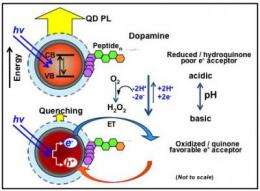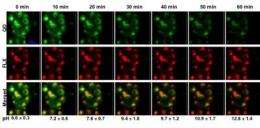NRL scientists unravel complex quantum dot-dopamine interactions

Scientists at the Naval Research Laboratory (NRL) in conjunction with the Scripps Research Institute in La Jolla, Ca., recently reported a detailed study of the interactions of water soluble semi-conductor quantum dots (QDs) with the electro-active neuro-transmitter dopamine.
These biocompatible QD-dopamine nano-assemblies may be used as the active component for sensors that are used to detect a wide variety of target analytes ranging from sugars to peroxides.
According to NRL's Dr. Michael Stewart, a member of the research team "The nature of the QD-dopamine interaction has been the subject of more than 25 recent research papers that attempted to uncover and exploit the exact nature of how the QDs interact with these small electro-active chemicals during the sensing process. Until now, it remained unclear as to whether dopamine acted as an electron acceptor or as an electron donor to quench luminescence from the QD."

"The chemical state of dopamine changes from a protonated hydroquinone in acidic media to an oxidized quinone in basic environments. A series of carefully designed experiments allowed the research team to establish that only the quinone form is capable of acting as an electron acceptor resulting in quenching of the QD emission. The rate of quinone formation and hence QD quenching is directly proportional to pH and can therefore be used to detect changes in the pH of solutions. Using this nano-scale sensor, the research team was able to demonstrate pH sensing in solution and even visualize changes inside cells as cell cultures underwent drug-induced alkalosis," explained Dr. Scott Trammell.
More information: The research was published in the August 2010 issue of Nature Materials.
Provided by Naval Research Laboratory

















